For Christians around the world, Palm Sunday marks the start of Holy Week leading into Easter Sunday. In this blog post, CHM curator of religion and community history Rebekah Coffman writes about the Polish traditions behind the day and when Polish president Lech Wałęsa attended a Palm Sunday Mass in Chicago in 1991.
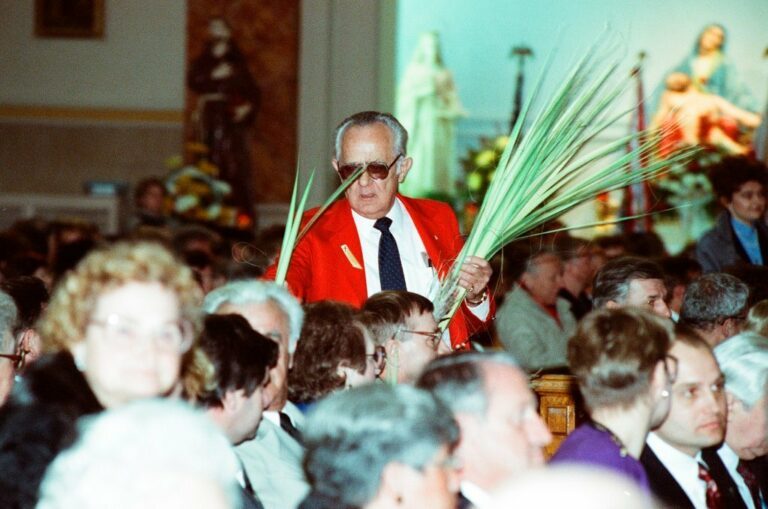
An usher distributes palm fronds at Palm Sunday Mass at St. Hyacinth Basilica, 3636 W. Wolfram St., Chicago, March 24, 1991. ST-19041696-0220, Chicago Sun-Times collection, CHM
In Christianity, Palm Sunday commemorates Jesus’s entry to Jerusalem when he was greeted by crowds waving palm branches. Many churches today across Christian denominations distribute palm fronds during services as preparation for the coming reminder of rebirth and life overcoming death.
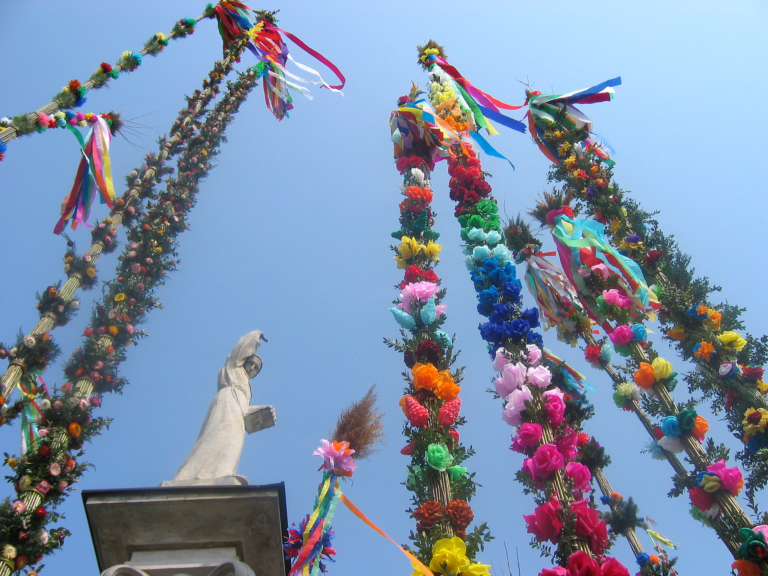
Palm Sunday in Lipnica Murowana, Poland, 2004. Maciej Szczepanczyk, Wikipedia Commons.
In Polish tradition, processions of palms take a major step beyond waving a single green branch. In fact, because palms are rare in Poland, palm branches are sometimes forgone completely, and beautiful bundles of willow (wierzba) and colorful bouquets of dried flowers are used instead. These incredible bundles are used in Sunday church services and afterward may be brought home or planted in fields as symbols of good luck. Some areas in Poland take decorating palms to a whole new level and hold annual contests for the tallest and most decorative display.
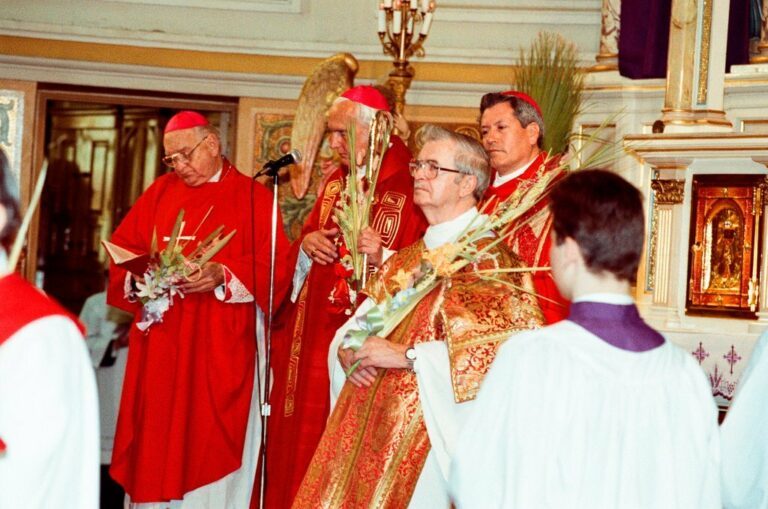
Palm traditions have extended here to Chicago, as can be seen in these images from a Palm Sunday service at St. Hyacinth’s Basilica (Bazylika Świętego Jacka) in the Avondale community area. St. Hyacinth’s was founded in 1894 by a group of Resurrectionists from St. Stanisłaus Kostka. Initially in a modest wood building, the congregation’s impressive Polish Cathedral-style church was built from 1917 to 1921.
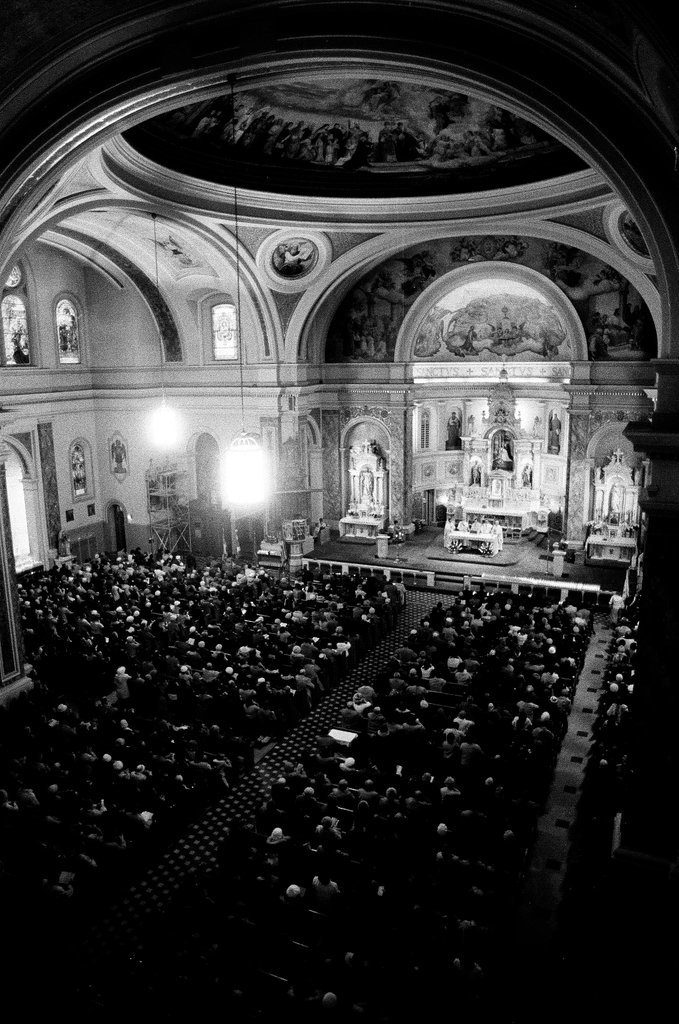
Overhead view of parishioners celebrating a mass at St. Hyacinth Basilica, Chicago, December 11, 1983. ST-19041501-0006, Chicago Sun-Times collection, CHM
The area of Avondale surrounding St. Hyacinth’s is also known as “Jackowo,” which when paired with the area surrounding nearby St. Wenceslaus Church (known as “Wacławowo”), is more generally known as the Polish Village. Avondale is historically known as a working-class neighborhood, developing along the Chicago River, rail lines, and brick factories. Beginning in the 1870s, a community of Black families in the Dawson subdivision called Avondale home. In the next few decades, the neighborhood quickly shifted as an influx of European migrants from Germany, Sweden, and Austria followed.
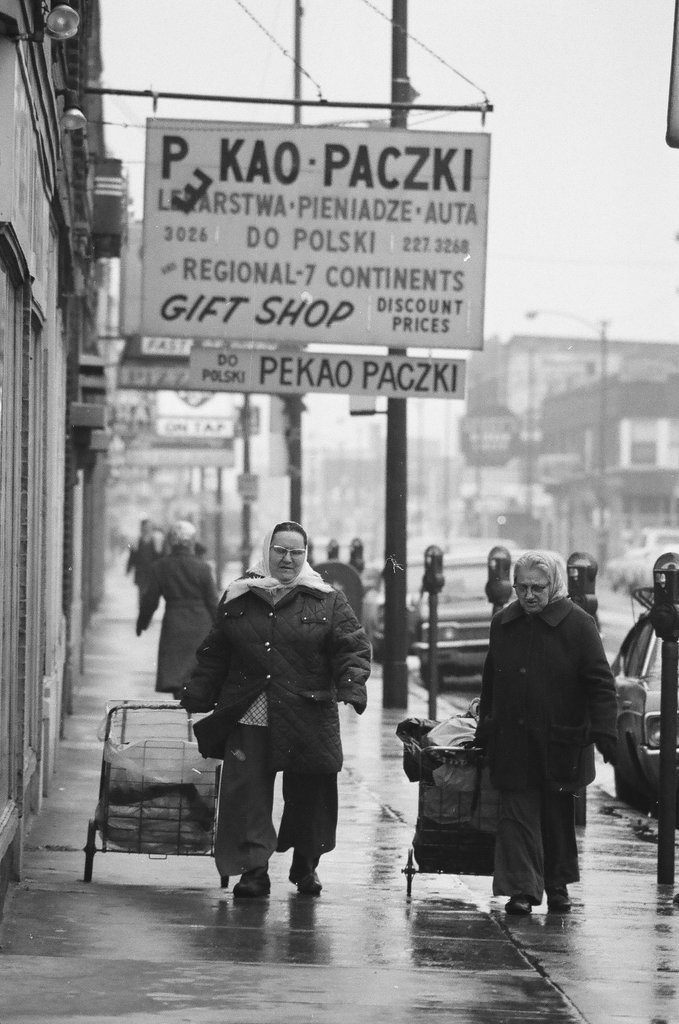
Pedestrians on North Milwaukee Avenue in Avondale, Chicago, January 24, 1975. ST-90003274-0020, Chicago Sun-Times collection, CHM
By 1930, nearly a third of Avondale identified as Polish, and the neighborhood remained predominantly Polish through the 1980s. Today, over half of Avondale identifies as Hispanic or Latine, with traces of its Polish Village community still present, though recent gentrification is once again shifting the neighborhood.
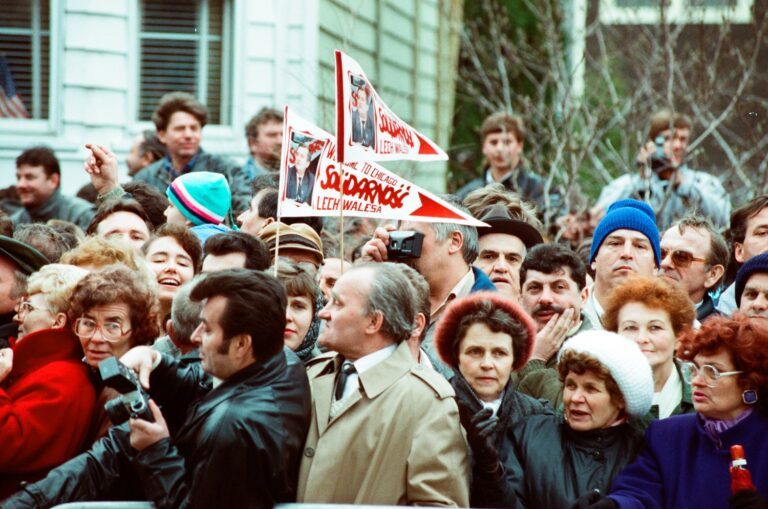
A crowd of people line the street to see Polish president Lech Wałęsa as he attends Palm Sunday Mass at St. Hyacinth Basilica, Chicago, March 24, 1991. Two people hold signs that welcome him and say “Solidarność,” which means “Solidarity” in Polish. ST-19041696-0190, Chicago Sun-Times collection, CHM
The Polish Avondale “heyday” of the 1980s and 1990s aligned with the Solidarity Movement in Poland, and Polish migrants to Chicago of this period included a number of political refugees escaping Communist rule. St. Hyacinth’s was a hub for Solidarity-era activity. In 1991, a large crowd of Polish Americans welcomed Solidarity leader and then-newly elected President of Poland Lech Wałęsa to St. Hyacinth’s for Palm Sunday Mass.
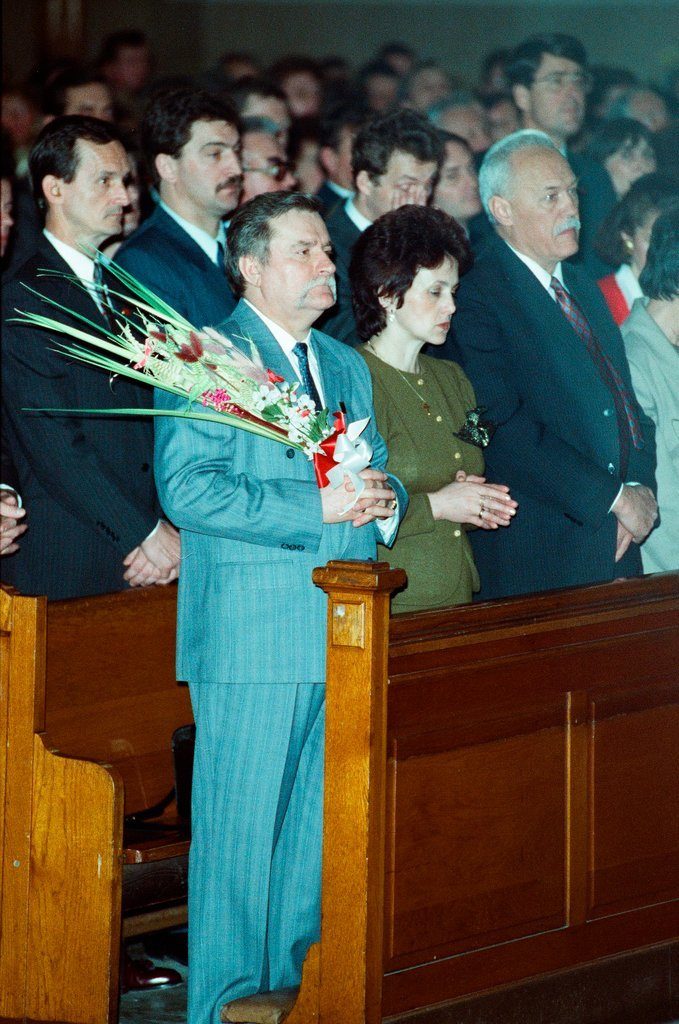
Lech Wałęsa (holding palm fronds and flowers) and his wife, Danuta, at Palm Sunday Mass at St. Hyacinth Basilica, Chicago, March 24, 1991. ST-19041696-0181, Chicago Sun-Times collection, CHM
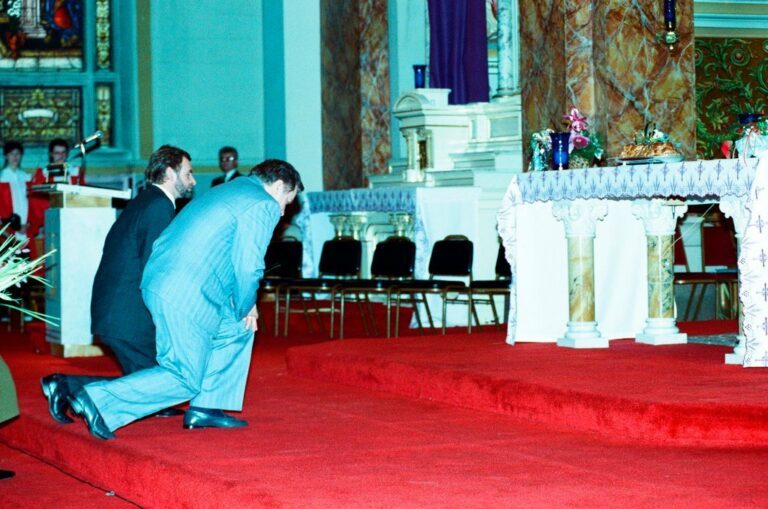
Lech Wałęsa (left foreground) genuflects during Palm Sunday Mass at St. Hyacinth Basilica, Chicago, March 24, 1991. ST-19041696-0158, Chicago Sun-Times collection, CHM
Solidarity initially referred to a trade union formed at the Lenin Shipyard in Gdansk, Poland, in 1980, which would go on to become the first independent trade union recognized by the state as part of the Warsaw Pact. As a leader of the Solidarity movement, Wałęsa was pivotal to ending Poland’s communist rule and became the first democratically elected president since 1926. He was president of Poland from 1990 to 1995.
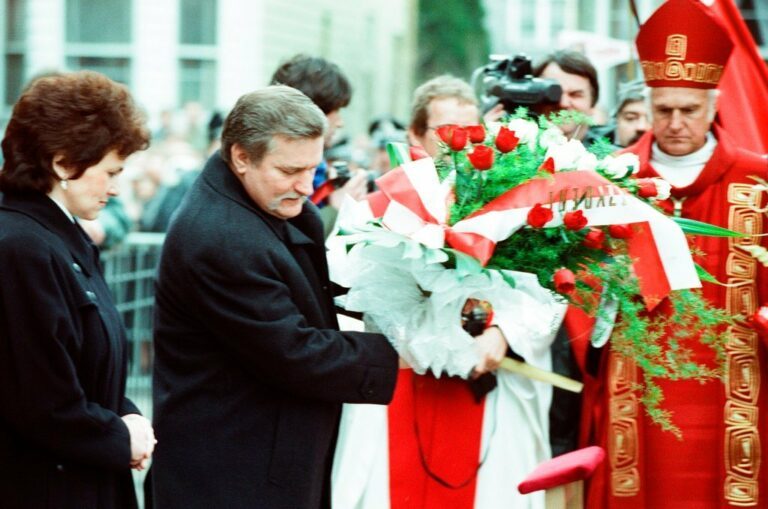
Lech Wałęsa and his wife, Danuta, handle a wreath outside St. Hyacinth Basilica, Chicago, March 24, 1991. ST-19041696-0138, Chicago Sun-Times collection, CHM
After the service, Wałęsa and his wife, Danuta, placed a wreath before a monument outside the church commemorating Fr. Jerzy Popiełuszko, a priest in Poland who was supportive of Solidarity and murdered by agents of Poland’s Security Service of the Ministry of Internal Affairs. Rev. Popiełuszko was recognized as a martyr by the Catholic Church and exemplifies the role churches played in the resistance movement during the antireligious suppression of the Communist era.
Additional Resources
- Listen to CHM’s Peter T. Alter interview Lech Wałęsa in 2012
- See more images of Lech Wałęsa visiting St. Hyacinth Basilica in 1991
- Learn more about Chicago area’s vibrant Polish communities from the mid-1800s to today in our exhibition Back Home: Polish Chicago (May 20, 2023–June 8, 2024)